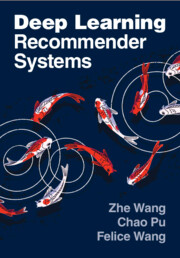Book contents
- Deep Learning Recommender Systems
- Reviews
- Deep Learning Recommender Systems
- Copyright page
- Contents
- Foreword
- Preface
- 1 Growth Engine of the Internet
- 2 Pre-Deep Learning Era
- 3 Top of the Tide
- 4 Application of Embedding Technology in Recommender Systems
- 5 Recommender Systems from Multiple Perspectives
- 6 Engineering Implementations in Deep Learning Recommender Systems
- 7 Evaluation in Recommender Systems
- 8 Frontier Practice of Deep Learning Recommender Systems
- 9 Build Your Own Recommender Systems Knowledge Framework
- Afterword
- References
1 - Growth Engine of the Internet
Recommender Systems
Published online by Cambridge University Press: 08 May 2025
- Deep Learning Recommender Systems
- Reviews
- Deep Learning Recommender Systems
- Copyright page
- Contents
- Foreword
- Preface
- 1 Growth Engine of the Internet
- 2 Pre-Deep Learning Era
- 3 Top of the Tide
- 4 Application of Embedding Technology in Recommender Systems
- 5 Recommender Systems from Multiple Perspectives
- 6 Engineering Implementations in Deep Learning Recommender Systems
- 7 Evaluation in Recommender Systems
- 8 Frontier Practice of Deep Learning Recommender Systems
- 9 Build Your Own Recommender Systems Knowledge Framework
- Afterword
- References
Summary
Recommender systems have become deeply integrated into daily life, shaping decisions in online shopping, news consumption, learning, and entertainment. These systems offer personalized suggestions, enhancing user experiences in various scenarios. Behind this, machine learning engineers drive the constant evolution of recommendation technology. Described as the “growth engine” of the internet, recommender systems play a critical role in the digital ecosystem. This chapter explores the role of these systems, why they are essential, and how they are architected from a technical perspective.
Information
- Type
- Chapter
- Information
- Deep Learning Recommender Systems , pp. 1 - 11Publisher: Cambridge University PressPrint publication year: 2025
